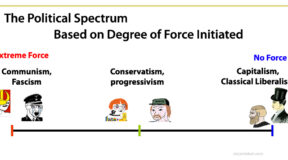
In the “What market failure” we will look at the various claims that the free market failed, and show that the principles of the free market did not fail, but where coercively distorted by government intervention.
Claim: Given the financial market challenges most pundits and politicians were quick to jump and blame troubles on free market. Banks fueled by greed made many bad investments.
The banks where fueled by something, but it wasn’t greed. Greed is a constant that has always been there.
One of the most important markets in an economy is the market for credit. The market for borrowing money. We do not have free markets for credit in the United States, or anywhere else that I know of. The price of credit is fixed by central banks. It is beyond me why most economists view with horror some government agency fixing the price of say, copper, but view the fixing of the price of credit by central banks as nothing to be alarmed at. It is only by accident that a central bank can fix the price of credit at a level that would be obtained on a free market. When the central bank lowers or raises the interest rate(the price of credit) below or above the equilibrium level which would of been obtained under free market, it creates or destroys credit much like a counterfeiter.
When the central bank lowers or keeps interest rates under the equilibrium level, this leads to credit creation. This encourages investments which are profitable only so long as the central bank prevents the interest rate from rising to its fre market equilibrium level. This action usually manifests itself in form of higher prices of goods and services, and higher prices of assets. At some point the central bank can no longer tolerate what it has done due to inflation and has to raise interest rates. If interest rates are raised above its free market equilibrium, this lead to credit destruction. This causes a decline in asset prices, an economic recession.
Banks occasionally do make bad investments, but the national scale and size of the current malinvestment could of only been possible with the help of the central bank. The U.S central bank, the federal reserve under Greenspan and Barnakee lowered and kept interests rates way to low for way to long. This encourage both banks and people to make investments that could only remain profitable under super low interest rates.
Under normal free market conditions, greed is curtailed by risk. The motive to reach a higher upside is curtailed by the fear of the downside. Every time it became apparent that some mal-investments were made and the market wanted to readjust its self, Greenspan intervened and cushioned the blow by lowering interest rates. This central bank intervention encouraged risk-takers to take on even more risk inasmuch as their upside rewards would seem to be unlimited but their downside punishment would be limited. The central bank created illusion that prices of assets(homes) would never go down.





1 Comment
Dr. Doom
(December 2, 2024 - 12:25 am)This argument makes several misleading claims:
1. Mischaracterization of Central Banking: Central banks adjust interest rates to stabilize economies, not arbitrarily distort markets. The claim that this is equivalent to counterfeiting ignores their role in managing inflation, employment, and economic growth.
2. Greenspan’s Policies Weren’t Sole Drivers: While low interest rates under Greenspan contributed to the housing bubble, private sector behaviors like excessive risk-taking, lack of transparency, and unregulated financial products were equally culpable.
3. Oversimplifies Asset Price Trends: The claim that central banks created the illusion of ever-rising home prices ignores broader market dynamics like lax lending standards and speculative investments by financial institutions.
4. Underestimates Market Failures: The narrative assumes free markets inherently self-correct efficiently, but history shows systemic risks (e.g., financial crises) often require external intervention. The unchecked market during the early 2000s fueled instability.